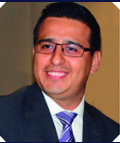
UAS
INGENIERIA
Experiencia Profesional
Universidad Autónoma de Sinaloa
Profesor Investigador de tiempo completo Titular C
Formación Académica
Doctorado
Doctorado en Ingeniería Sísmica
Instituto de Ingeniería, UNAM
Maestría
Maestría en Ingeniería Estructural
Instituto de Ingeniería, UNAM
Licenciatura
Licenciatura en Ingeniería Civil
Universidad Autónoma de Sinaloa
Eden Bojorquez Mora
LICENCIATURA EN INGENIERÍA CIVIL
EDÉN BOJÓRQUEZ MORA Profesor Investigador de Tiempo Completo Titular C de la Facultad de Ingeniería de la Universidad Autónoma de Sinaloa. Obtuvo el grado de Licenciatura en Ingeniería Civil por la Facultad de Ingeniería de la Universidad Autónoma de Sinaloa con mención honorífica. Posteriormente curso estudios de Maestría y Doctorado en Ingeniería en el Instituto de Ingeniería de la UNAM donde obtuvo el grado con mención honorífica. PREMIO a la mejor tesis Doctoral en el sexto Concurso Nacional de Tesis de Doctorado (2 9) otorgado por la Sociedad Mexicana de Ingeniería Sísmica. PREMIO por el artículo más sobresaliente de la Revista de Ingeniería Sísmica (Revista Científica de Excelencia por CONACYT) durante el periodo 2 9-2 como autor único, otorgado por el Presidente de la Sociedad Mexicana de Ingeniería Sísmica Dr. Jorge Aguirre González. PREMIO por dirigir la mejor tesis de Posgrado a nivel Estado otorgado por INAPI 2 -2 4 y las mejores tesis de Licenciatura a nivel nacional relacionadas a la Ingeniería Estructural por la Sociedad Mexicana de Ingeniería Estructural en 2 6. Realizó una estancia Posdoctoral en el Departamento de Ingeniería Estructural de la Universidad de Nápoles Federico II en Italia. Profesor-Investigador Repatriado por el Consejo Nacional de Ciencia y Tecnología a la Facultad de Ingeniería de la Universidad Autónoma de Sinaloa (2 8-2 9). Es miembro del Sistema Nacional de Investigadores, y miembro honorífico del Sistema Sinaloense de Científicos y Tecnólogos, así como del Cuerpo Académico Consolidado de Estructuras y Mecánica Básica. Autor de más de 2 artículos en Revistas Científicas y Congresos Nacionales e Internacionales. Ha sido director de 47 tesis de Licenciatura, Maestría y Doctorado, actualmente dirige varias tesis de Maestría y de Doctorado incluyendo de estudiantes de la UNAM y UABC, y ha supervisado a más de estudiantes durante veranos de la investigación científica. Es revisor de las revistas Earthquakes and Structures, Earthquake Spectra, Bulletin of Earthquake Engineering, Engineering Structures, Earthquake Engineering and Engineering Vibration, Wind and Structures, Journal of Civil Engineering de Korean Society of Civil Engineering KSCE, Ingeniería, Investigación y Tecnología editada por la Facultad de Ingeniería de la UNAM e Ingeniería Civil Sostenible, DYNA Colombia entre otras así como Revisor de artículos para el 5th World Conference on Earthquake Engineering y Moderador en eventos académicos. Miembro del Comité Científico del 6th World Conference on Earthquake Engineering y otros Congresos Nacionales e Internacionales, ha dado varias conferencias incluyendo magistrales en países como Emiratos Arabes Unidos (en Dubai). Es miembro del Registro CONACYT de Evaluadores Acreditados RCEA y de la Sociedad Mexicana de Ingeniería Sísmica. Ha participado en la evaluación de proyectos de investigación de ciencia básica del CONACYT, así como en la evaluación de proyectos de investigación del Programa de Fomento y Apoyo a Proyectos de Investigación PROFAPI de la Dirección General de Investigación y Posgrado de la Universidad Autónoma de Sinaloa y de otras Universidades. Es revisor de proyectos para asignar fondos a grupos de investigación por parte del Ministerio Italiano de Educación. Coordinador de la apertura de la Maestría y Doctorado en Ciencias de la Ingeniería en la Facultad de Ingeniería Culiacán de la Universidad Autónoma de Sinaloa 2 9. Participó en la elaboración de los Proyectos de Maestría y Doctorado en Ciencias de la Ingeniería para su incorporación al Programa Nacional de Posgrados de Calidad del CONACYT (ambos pertenecen al Padrón de excelencia del CONACYT). Actualmente, es el Coordinador de la Maestría y Doctorado en Ciencias de la Ingeniería en la unidad Culiacán y es miembro del Comité Académico y Núcleo Académico Básico de dichos Programas. Es el Editor de la Revista de Ingeniería Sísmica de la Sociedad Mexicana de Ingeniería Sísmica la más prestigiosa en el mundo en su área escrita en español (también acepta trabajos en inglés) y que se encuentra indizada en CONACYT, SCIELO, LATINDEX, REDALYC, etc. Además ha sido Editor invitado de la Revista Advances in Civil Engineering que se encuentra indizada en JCR. En 2 7 brindó apoyo técnico como evaluador de escuelas dañadas por sismos. Actualmente es Editor de la Revista Ingeniería y Tecnología UAS. En 2 6 fue Galardonado con el Premio Ingeniero Civil del Año otorgado por el Colegio de Ingenieros Civiles del Estado de Sinaloa 2 6-2 7. Fungió como VICEPRESIDENTE de la Sociedad Mexicana de Ingeniería Sísmica en 2 6-2 7, y ha impartido cátedras sobre Ingeniería Sísmica en el Colegio de Ingenieros Civiles de México. Entre sus aportaciones científicas destaca la creación de una nueva medida de intensidad sísmica (Intensidad IB) representativa del potencial destructivo de un terremoto, la cual está siendo reconocida por investigadores de las instituciones más prestigiadas a nivel mundial tales como las Universidades de Stanford en Estados Unidos, Imperial College de Londres, Stanford, Bolonia, Pavía, Nápoles en Italia, Grenoble Francia, entre otras. Actualmente, el Dr. Bojórquez está trabajando en la generación de registros sísmicos, de viento, mapas de peligros naturales, fragilidad de estructuras, edificios con disipadores de energía, diseño sismo-resistente sustentable y otros temas encaminados al futuro desarrollo de un Reglamento de Construcción específico para los Municipios del Estado de Sinaloa.
-
Área de conocimiento: Ingenierías y Desarrollo Tecnológico
-
Grado: Licenciatura
-
Institución: UAS
-
Correo: eden@uas.edu.mx